After presenting IP Fabric at Networking Field Day 23, a number of Twitter threads started probing at the idea of Intent-Based Networking (IBN) - is it simply a marketing term that vendors use to sell more gear or does it have a deeper meaning? And what impact does it have on the network team? Does it automate them out of a job?
It’s safe to say that every modern business depends on its IT, and the network provides the underpinning to all the systems on which we rely. Business needs IT to just “be”. It should be permanently available, supporting business process with a minimal operational overhead. But it’s obvious to anyone in IT just how big a stretch that is due to many factors, not least:
Automating regularly occurring network tasks helps reduce the operational overhead of running the network, of course. You might use controllers or scripts, templates, zero-touch provisioning and automated change mechanisms. There are plenty of benefits in being able to treat a network domain as a macro entity and allow the micro tasks that are required to maintain the environment be taken care of by automated processes.
However, it's vital that we fully understand the networks we build. This ensures that the automation platform is deploying configuration with the expected outcome. Configuration still happens in a network domain on a box-by-box basis. The process uses configuration detail from a knowledgeable and experienced network engineer. In reality, the automation system functions like a fast, consistent network analyst. It makes and tests changes and fetches data about operations, based on rules defined by its "superiors"!
IBN takes the automation approach to the next level. Given the business intent for the network, you first translate it to a set of technical capabilities, then:
What we’re really doing here though is subtly evolving the roles of the network architect, designer and engineer.
The business intent may include such abstract ideas as “make sure that my critical applications are always available”. The traditional approach would involve a network architect in translating that intent to some design criteria: “always use High Availability, no SPOFs, converge my routing protocol within x seconds, define QoS across the network” and so on. A network designer will then take those principles, and looking at each network domain in turn, consider how to turn out specific bills of material, Layers 1, 2 and 3 topologies and designs using specific vendor platforms. The network engineer would finally deploy this. They would turn the designs into actual configuration, and then manage and maintain the resulting network.
IBN automates much of this process, taking business intent and delivering a self-regulating, self-healing network environment.
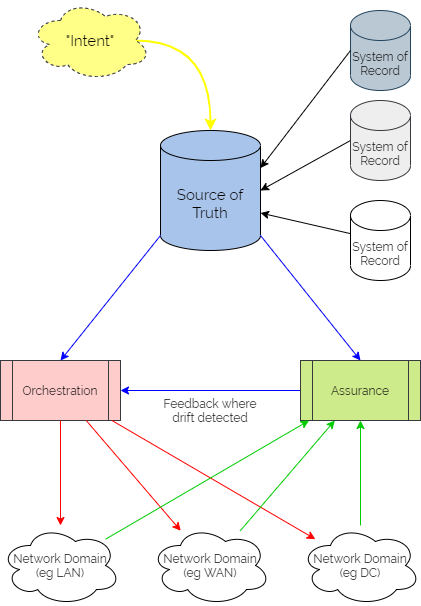
It centres on a “Source of Truth” (SoT) – a picture of the network as it is intended to look, developed from the business intent using logic defined by the network architects and designers. It is then used as a central reference point for all intended configuration data – often referring to other “Systems of Record” as definitive reference sources where necessary.
Updating intent in the SoT triggers orchestration workflows to render the configuration in the different network domains. These configurations might include organisational or industry Best Practice templates, security policy data or specific network domain detail to support the intent. And typically the orchestration workflows then kick off automation tasks in controllers or as scripts to interact with different sets of network devices, potentially from different families from different vendors. Subsequently, they might also update policy engines which devices are using to refer to without having to keep local copies of configuration or policy.
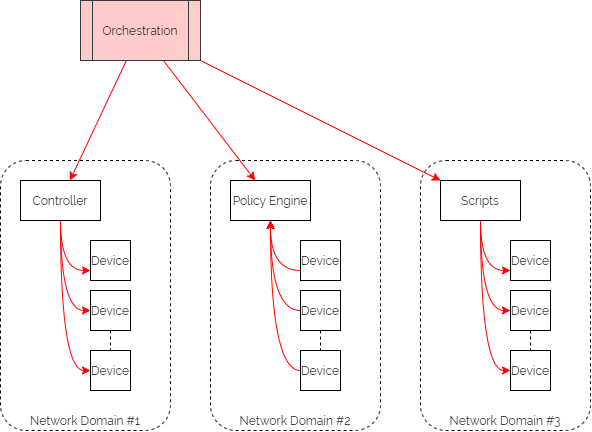
Assurance workflows are built first to harvest state information from the network devices and controllers. They then analyse that data to ensure that they are meeting the intent.
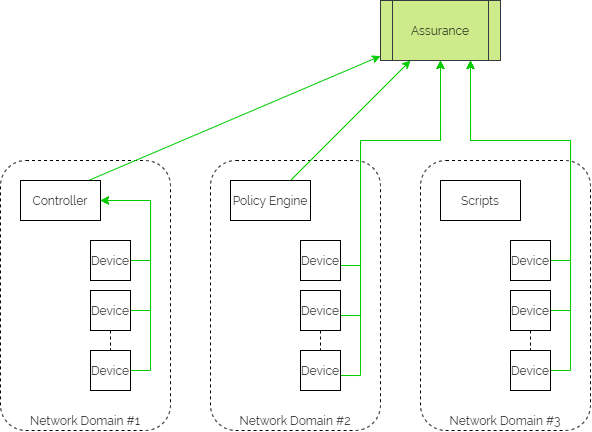
And if intent is not being met, the assurance element then triggers a feedback loop into the orchestration platform to update configuration through the automation layer.
There are of course a few words of caution.
And so you can see, the network architect, designer and engineer are still key - they simply demonstrate their knowledge and experience in different ways.
As we mentioned in our earlier post, IP Fabric is not well-positioned as the SSoT for intent, simply because the product focus is on being the informational reference for the actual network state.
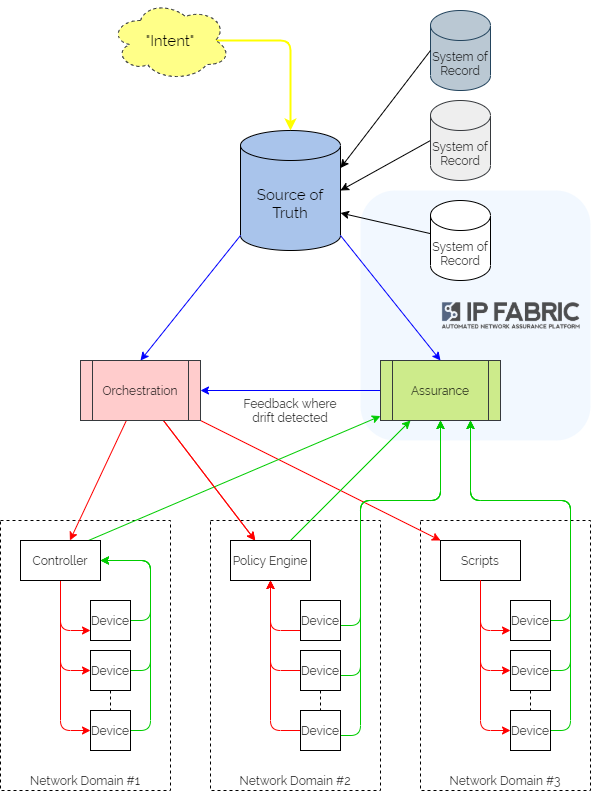
IP Fabric can sit squarely at the heart of your intent-based networking ecosystem however. As it provides full inventory, configuration and state visibility of the entire network, it then becomes well-placed to serve as the System of Record for those elements. It would be used to carry out an initial population of the Source of Truth, and then as a regular source of true-up data to ensure that the SoT genuinely represents the active network.
As IP Fabric is already harvesting all the network data, it is in a great position to begin carrying out the assurance elements of the IBN system. We would define rules in IP Fabric that validate elements of configuration and state, which are checked at every snapshot. Rules are not only created through the UI but also through the API. This means that they can then be pushed to the platform from an agent acting for the Source of Truth. Webhooks can then be fired from IP Fabric at calculation of those intent verification rules, to provide a feedback mechanism to the orchestration platform should intent not be met.
The real beauty of using IP Fabric with its complete network database and open API is that it can then serve as a reference source for whoever else needs that network data. The same system operating as part of the IBN platform could thus be used to keep monitoring platforms up to date, feed data to ITSM tickets at creation time, and later be queried through slash commands in Slack.
And so, the network engineer already has all the detailed configuration and state data they need to maintain, troubleshoot and deploy the networks they run. The network designer has an understanding of inventory, and topology relatinships at all layers. And the network architect can then get a picture very quickly of the current state of the interoperation of the network domains to help plan for transformation.
If you have found this article helpful, please follow our company’s LinkedIn or Blog, where more content will be emerging. If you would like to test our solution to see for yourself how IP Fabric can help you manage your network more effectively, please contact us through www.ipfabric.io.
A lively debate sparked up after Networking Field Day 23, where we presented IP Fabric to a panel of delegates and hundreds of eager online viewers. Could we class our solution as a "Source of Truth" for the network? The conclusion was "Yes". And "No". So why the confusion and what did the question actually mean? I thought I'd try and get to the bottom of it!
Network automation has come a long way. Once, that meant CLI scripts that you created by "mail merge", then rolled into your network over a telnet session. Now we have sophisticated automation platforms that take desired state and through configuration templates, functions, modules, and APIs, can push that state into network devices (and if you're really lucky, roll them back again if they didn't complete.) But where does that desired state come from? You need to decide and record which features and parameters you want to enable and push out to which devices ...
And so you create a database - a bunch of spreadsheets, SQL, DCIM (Data Center Infrastructure Manager), or IPAM (IP Address Management) system - containing those feature definitions and parameters. And your templates are rendered using the data from that system into intended config state. This is typically referred to as the "Source of Truth", SoT (or sometimes "Single Source of Truth", SSoT).
The idea is that there is only one place to store that data - the ultimate reference source of desired configuration. Update that and the implied intention is that the network config is required to be changed. Typically that information would be version-controlled and tracked, often using git or a similar VCS (version control system).
... when it doesn't hold all the information in one place! A Single Source of Truth can simply be a placeholder or proxy for the collection of reference sources for individual pieces of the network data puzzle.
You may use an IPAM system to record the definitive IP addressing schema that you want to use. You may use a CMDB to track your network device inventory details. These would be referred to as Systems of Record. Ultimately your network automation needs to access information from both of these sources in order to render configurations. So an SSoT would zip that information together as required.
Within the accepted conventional definition, not really. As the inventory, configuration, and state data in IP Fabric is harvested from network devices, it doesn't represent intended state. It isn't able to be changed or updated manually. IP Fabric builds vendor-neutral snapshots of the state of the network as a whole. It reflects - in great detail - the state of the network as it is operating at a point in time. It is queried through Web UI or API, visually or in tabulated data. As such, it doesn't store intended state, but the actual state.
But that's not the complete story. Because along with the data from the network, we can build a series of intent verification checks. We use filters and classifications on that data to verify that the active network complies with an intended state. For a simple example, we can ensure that all network devices are configured to a specific set of management parameters. We verify that NTP, SNMP, and syslog match a set of criteria at every snapshot, and present a compliance report.
The 150+ embedded verification checks that ship with the platform range from the simple (eg checking where VLAN 1 is in use) to the complex (eg ensuring Spanning Tree root and FHRP active gateways align) and everything in between (eg checking MTU sizes at either end of a link match).
Whilst there is a mechanism to store intent in IP Fabric, it isn't used to render the intent as configuration. Verification checks are run against every snapshot and provide us with a way of validating intent on an ongoing basis.
We also carry out simulated end-to-end path checks at each snapshot. This allows us to validate that paths are as you expect them, and firewall rules allow connections only as intended.
All of these intent verification checks are built through either Web UI, or IP Fabric's extensive REST API. This provides us with the ability to update the intent verifications in IP Fabric while you render the configurations from the intended state data, thus confirming at each snapshot that the state is matching the original intent from the SoT.
IP Fabric's new webhooks feature which allows us to notify an external platform when verification checks are completed. This can be used to provide a feedback mechanism for when actual state has drifted from intended state.
In IP Fabric we compare the intent with the network state that is discovered at the time of the snapshot. If for some operational reason, a part of the network is down, or if a partial snapshot is run to validate a change in a particular area of the network, then we only have partial data. And that is not useful for expressing intent across the whole network.
It is more optimal to use IP Fabric in tandem with a dedicated SoT like the open-source project Netbox. IP Fabric would then be used to cross-validate that the data in the SoT is correct and up to date. This effectively treats IP Fabric as a System of Record for active network state. An automation platform like Ansible might then be used to render configurations.
Using the API, IP Fabric intent verification rules can be built from the data defined in the SoT to confirm that the network configuration and behaviors matches the intent expressed in the templates. If state doesn't match intent, webhooks can be used to notify the orchestration/automation platform that adjustments need to be made. So not only would we automate the network device configuration from the SoT but also IP Fabric configuration!
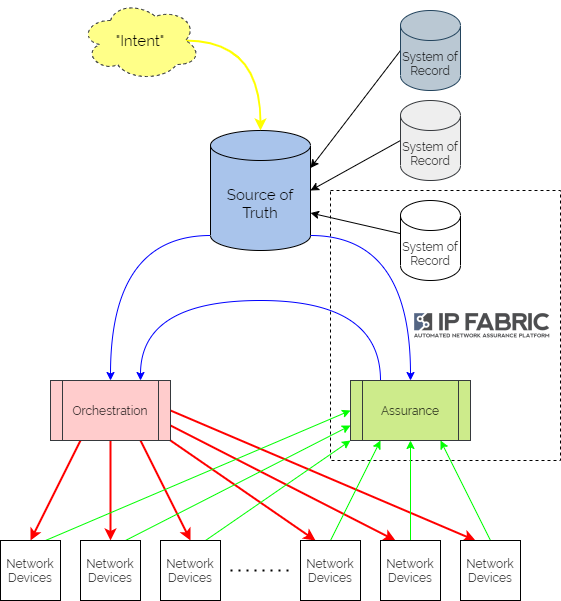
Based on current accepted definitions, IP Fabric would not be considered a "Single Source of Truth" for intended state. It would be more accurately considered a System of Record for existing network state. It would be used in conjunction with a SSoT to measure compliance with intent. And if required, it would then trigger activity to rectify any drift.
Look out for the next article, where we'll consider Intent-Based Networking in a little more detail!
If you have found this article helpful, please follow our company’s LinkedIn or Blog, where more content will be emerging. If you would like to test our solution to see for yourself how IP Fabric can help you manage your network more effectively, try our free online demo here: Self-Guided Demo.


